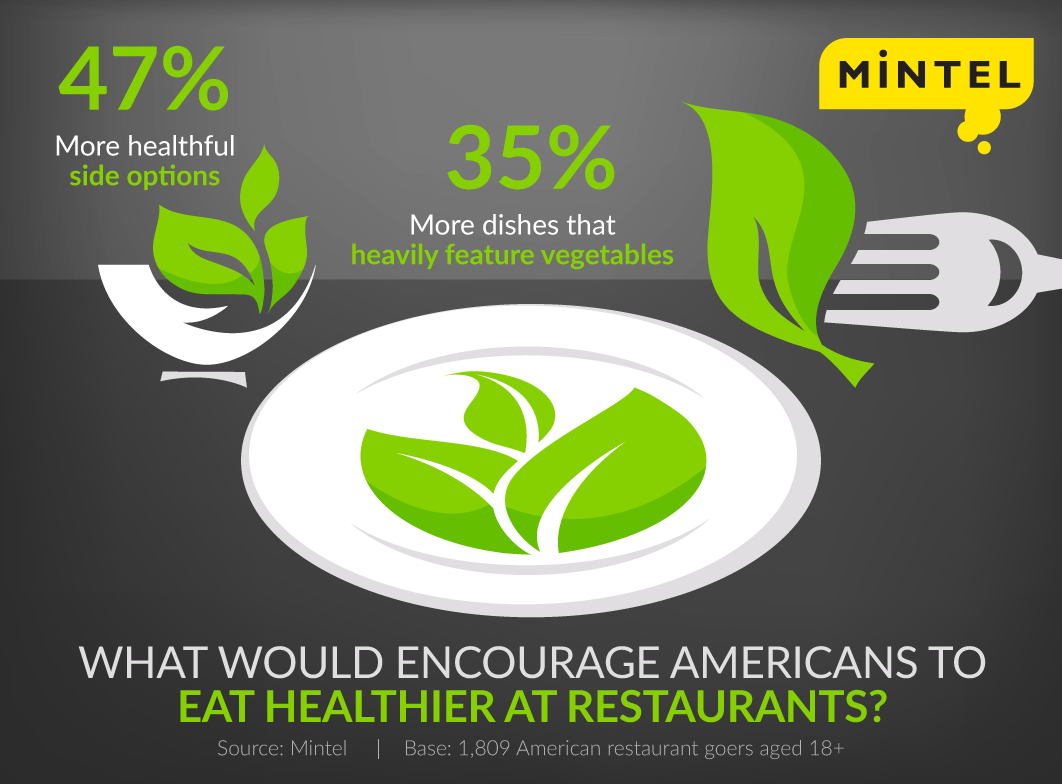Half of Americans agree that finding healthy items at restaurants is challenging
As Americans shift their dietary focus away from counting calories and toward holistic wellness, consumers are looking for restaurants to provide clear indicators of healthy items. New research from Mintel reveals half (48 percent) of consumers agree that finding healthy items at restaurants is too difficult, with 25 percent of Americans looking for nutritional claims on menus more in 2015 than the year before. What’s more, 68 percent of consumers agree that more restaurants should call out healthy claims on menus.
64% of restaurant goers agree that many healthy dishes are too expensive
As consumers look to incorporate healthier, more well-rounded diets as part of their daily lives, 36 percent are more frequently preparing healthier food at home instead eating at restaurants compared to last year*. Further, 64 percent of consumers believe many healthy restaurant dishes are too expensive.
However, consumers appear willing to indulge when dining out despite their interest in health: 62 percent of restaurant goers agree that taste is more important than nutrition, with 86 percent saying that dining out is a treat. One way restaurants can satisfy consumers looking to indulge is by offering healthy substitutions. Nearly half (46 percent) of restaurant goers are interested in more healthful side options, and 27 percent are already replacing unhealthy sides with healthier options compared to last year. Another one third (35 percent) of consumers are interested in more dishes that heavily feature vegetables.
“As Americans adopt a more holistic approach to their diets, they expect clarity from foodservice establishments, specifically by making healthy items easily identifiable and including more nutritional claims on menus. At the same time, many consumers view dining out as a way to indulge,” said Caleb Bryant, Foodservice Analyst at Mintel. “Restaurants should offer consumers a way to indulge and also incorporate nutrition by expanding menus to include more healthy sides, while also showcasing healthful preparation methods, such as grilled instead of fried foods. This provides options for whatever mood diners are in, whether they want to eat healthy, are looking to indulge, or possibly do both.”
Health is a top priority for parents, with regard to their children and themselves. Two in five (39 percent) are ordering healthier food for their children more this year compared to last, and two thirds (66 percent) of parents would pay more for healthy foods when dining out (vs 41 percent of non-parents). Three in five (62 percent) parents agree that healthiness of menu items is the most important factor when choosing a restaurant compared to 36 percent of non-parents.
While parents are focused on healthy eating for their families, 88 percent view dining out as a treat. As such, Mintel research shows that one quarter (25 percent) of parents allow children to treat themselves and eat unhealthy foods when dining out.
“Kids’ meals are notorious for having low nutritional value, and restaurants have taken steps to add more healthful menu items for children in recent years. But while healthy dining is very important to families, restaurants need to remember that dining out is also considered a treat by many and an opportunity to indulge, even for children. Like adults, restaurants should look to cater to children who want nutritious items and those looking to treat themselves,” continued Bryant.
Another expanding area of concern for foodservice is consumer interest in better-for-you (BFY) alternatives to high sugar drinks. One quarter (23 percent) of Americans are ordering less carbonated soft drinks at restaurants compared to a year ago, and two in five (38 percent) agree that most soft drinks are too high in sugar. This negative perception leaves the door open for restaurants to differentiate with BFY options, as consumers would like to see more all-natural beverages (38 percent), more iced tea options (31 percent) and more flavored waters (25 percent).
“As evidenced by struggling retail sales of carbonated soft drinks, consumers are looking for alternatives to high sugar drinks. As soft drinks have been a major revenue stream for the restaurant industry over the years, it’s important that restaurants adapt to consumers’ better-for-you preferences. All-natural beverage options like iced teas and flavored waters offer a healthier alternative for restaurant goers while providing a chance for restaurants to tap another revenue source,” concluded Bryant.
*Survey conducted December 2015
Press copies of the Healthy Dining Trends US 2016 report and interviews with Caleb Bryant, Foodservice Analyst, are available on request.
For the latest in consumer and industry news, top trends and market perspectives, stay tuned to Mintel News featuring commentary from Mintel’s team of global category analysts.
-
 Discover your next big breakthroughGet smart fast with our exclusive market research reports, delivering the latest data, innovation, trends and strategic recommendations....View Reports
Discover your next big breakthroughGet smart fast with our exclusive market research reports, delivering the latest data, innovation, trends and strategic recommendations....View Reports -
2026 Global PredictionsOur Predictions go beyond traditional trend analysis. Download to get the predictive intelligence and strategic framework to shape the future of your industry in 2026 and beyond. ...Download now
-
Are you after more tailored solutions to help drive Consumer Demand, Market Expansion or Innovation Strategy?Ask for a customised strategic solution from Mintel Consulting today....Find out more
































